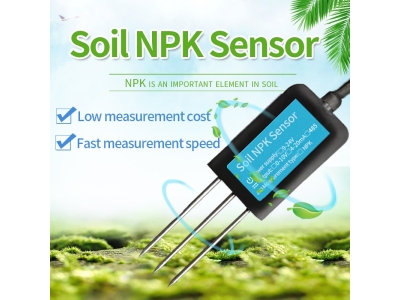
How do soil sensors detect it?
Soil sensors play a crucial role in modern agriculture and environmental monitoring by providing valuable data on soil moisture, temperature, and nutrient levels.

Soil sensors play a crucial role in modern agriculture and environmental monitoring by providing valuable data on soil moisture, temperature, and nutrient levels.
Soil sensors play a crucial role in modern agriculture and environmental monitoring by providing valuable data on soil moisture, temperature, and nutrient levels. These sensors utilize various technologies to measure and detect these parameters accurately. This article explores the working principles and mechanisms behind soil sensors, shedding light on how they detect soil conditions. Understanding the inner workings of soil sensors is essential for optimizing agricultural practices, conserving resources, and promoting sustainable farming.

I. Soil Moisture Sensors:
Soil moisture sensors are designed to measure the amount of water present in the soil. They utilize different techniques to determine soil moisture content, including capacitance, tensiometry, and time domain reflectometry.
A. Capacitance Sensors:
Capacitance sensors operate based on the principle that the dielectric constant of soil is directly proportional to its moisture content. These sensors consist of two electrodes inserted into the soil, forming a capacitor. The sensor measures the capacitance between the electrodes, which changes with varying soil moisture levels. By calibrating the sensor with known moisture levels, it can provide accurate readings of soil moisture content.
B. Tensiometers:
Tensiometers measure soil moisture based on the principle of soil water potential or tension. These sensors consist of a ceramic cup filled with water and a porous material, such as ceramic or gypsum, which is inserted into the soil. As soil moisture decreases, the tension in the soil increases, causing water to be drawn from the tensiometer. The sensor measures the tension in the tensiometer, providing an indication of soil moisture levels.
C. Time Domain Reflectometry (TDR) Sensors:
TDR sensors use electromagnetic pulses to measure soil moisture content. They send a pulse along a probe inserted into the soil and measure the time it takes for the pulse to return. The travel time is influenced by the dielectric properties of the soil, which change with varying moisture levels. By analyzing the travel time, the sensor can determine the soil moisture content accurately.
II. Soil Temperature Sensors:
Soil temperature sensors are used to measure the temperature of the soil. They employ different technologies, including thermocouples, thermistors, and resistance temperature detectors (RTDs), to detect soil temperature accurately.
A. Thermocouples:
Thermocouples utilize the principle of the Seebeck effect to measure temperature. These sensors consist of two dissimilar metal wires joined at one end. When there is a temperature difference between the joined end and the free ends, a voltage is generated. This voltage is proportional to the temperature difference and can be measured to determine the soil temperature.
B. Thermistors:
Thermistors are resistive devices that exhibit a change in resistance with temperature. These sensors consist of a temperature-sensitive semiconductor material, such as ceramic or polymer. As the soil temperature changes, the resistance of the thermistor changes accordingly. By measuring the resistance, the sensor can determine the soil temperature accurately.
C. Resistance Temperature Detectors (RTDs):
RTDs are temperature sensors that utilize the principle of electrical resistance. These sensors consist of a wire made of platinum, copper, or nickel with a known resistance-temperature relationship. As the soil temperature changes, the resistance of the wire changes proportionally. By measuring the resistance, the sensor can calculate the soil temperature accurately.
III. Soil Nutrient Sensors:
Soil nutrient sensors are designed to measure the concentration of various nutrients present in the soil, such as nitrogen, phosphorus, and potassium. These sensors utilize different techniques, including ion-selective electrodes and optical sensors, to detect soil nutrient levels.
A. Ion-Selective Electrodes:
Ion-selective electrodes are used to measure the concentration of specific ions in the soil solution. These sensors consist of a membrane that selectively interacts with a particular ion of interest, allowing it to pass through. The electrode measures the potential difference generated by the ion interaction, which is proportional to the ion concentration in the soil.
B. Optical Sensors:
Optical sensors employ the principle of light absorption or reflection to measure soil nutrient levels. These sensors emit light at specific wavelengths into the soil and measure the intensity of light absorbed or reflected by the soil. The absorption or reflection characteristics change with varying nutrient concentrations, allowing the sensor to determine nutrient levels accurately.
IV. Data Collection and Analysis:
Soil sensors generate a vast amount of data that needs to be collected, stored, and analyzed to extract meaningful information. This is typically achieved through data loggers or wireless networks connected to a central database or cloud platform. Data analysis techniques, such as statistical analysis, machine learning, and artificial intelligence algorithms, are then applied to interpret the sensor data and provide actionable insights.
Conclusion:
Soil sensors play a vital role in agriculture and environmental monitoring by providing valuable data on soil moisture, temperature, and nutrient levels. These sensors employ various technologies, including capacitance, tensiometry, time domain reflectometry, thermocouples, thermistors, RTDs, ion-selective electrodes, and optical sensors, to detect and measure soil conditions accurately. Understanding the working principles behind soil sensors is essential for optimizing agricultural practices, conserving resources, and promoting sustainable farming. With advancements in sensor technology and data analysis techniques, soil sensors will continue to play a crucial role in improving soil management, enhancing crop productivity, and ensuring environmental sustainability.